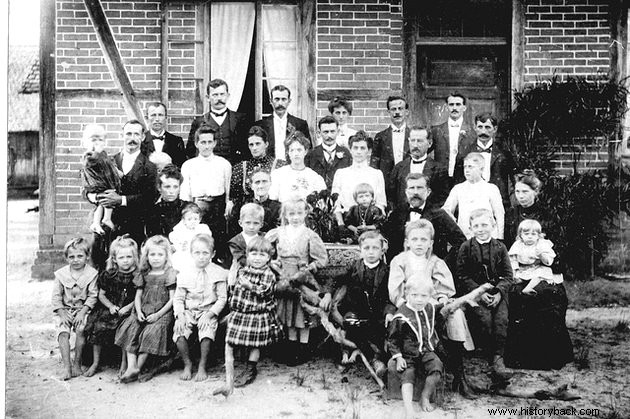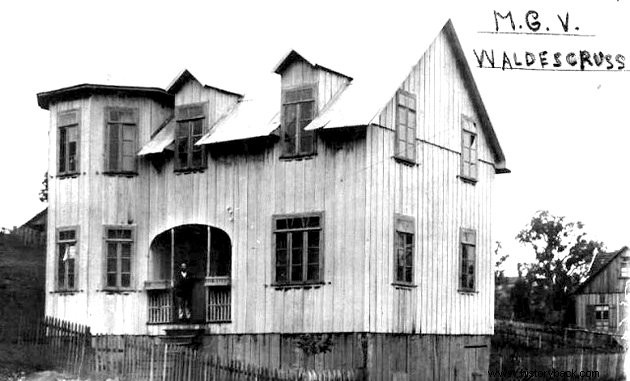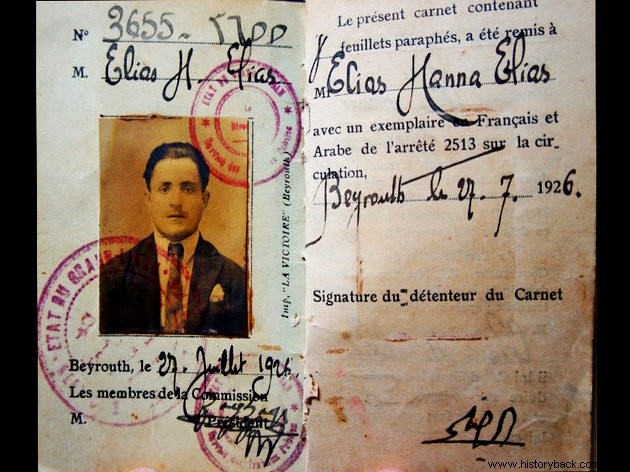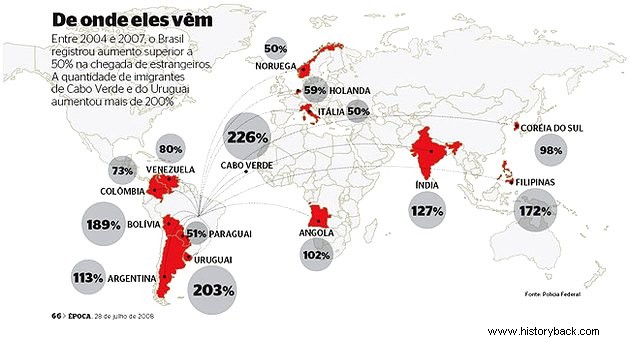The process of immigration in Brazil began in 1850 with the end of the slave trade.
Wanting to erase the Brazilian slaveholding heritage, the government began to encourage the entry of European immigrants, in order to promote the "whitening" of the population.
Characteristics of immigration in Brazil
The opening of ports, which took place in 1808, allowed the entry of non-Portuguese immigrants to Brazil. At the moment, several European scientific expeditions visit and promote the Portuguese colony in Europe. The installation of liberal professionals is also registered, especially in Rio de Janeiro.
With the prohibition of the slave trade in 1850, the development of coffee plantations and racial prejudice induced the entry of European immigrants into the country.
With the wars of unification in Italy and Germany, they are brought by the Brazilian government to work in the coffee plantations.
 See also:End the African Slave Trade
See also:End the African Slave Trade
Partnership and settlement system
European immigration in Brazil was not homogeneous for all regions. In São Paulo, we observed the implementation of the partnership system, where the immigrant came to work on the coffee farms.
In the south of Brazil, the concern was to populate the large desert regions to protect the border. Therefore, the settlement system is applied there.
Let's see the difference between the two systems.
Partnership System
In the first, immigrants who wished to come were hired by the owners of the farms. These paid for the ship's ticket, travel from the port to the farm, and lodging. In this way, they arrived at their destination in debt and without being able to obtain the dreamed ownership of the land.
Likewise, the settlers could not abandon the farm until they had paid what they owed.
This system was so cruel that a revolt of German immigrants was recorded on the Ibicapa farm, owned by Senador Vergueiro, in São Paulo. The consequence was the prohibition of Prussian immigration to Brazil in 1859.
Settlement System
In the second phase, the colonato system was applied and the arrival of immigrants was assumed by the provincial (state) governments. Thus, the immigrant was not in debt.
They also received monthly or annual remuneration, could grow food for their livelihood, and were free to leave the property.
This system was more attractive to immigrants and many colonies were able to prosper.
Immigrants in Brazil
Before the arrival of the Portuguese, it is important to note that the territory already had an indigenous population of around 5 million inhabitants. In turn, Africans were brought in by force.
So, who is an immigrant in Brazil, if only the indigenous are the natives? For the purposes of studies, we will consider as an immigrant only the individual who arrived in the country free.
Swiss

The first non-Portuguese European immigrants to settle in Brazil were the Swiss. Due to the lack of land in Switzerland, around two thousand people immigrated to the country between 1818 and 1819 and became "subjects of the King of Portugal."
As their arrival was negotiated with the canton of Friburgo, the place where they stayed was renamed Nova Friburgo, in Rio de Janeiro.
Despite adverse conditions, Swiss immigration continued throughout the 19th century, and settlers settled in the mountainous region of Rio de Janeiro and in the states of São Paulo, Paraná, Santa Catarina, Espírito Santo and Bahia.
In Santa Catarina, several Swiss families populated Colônia Francisca, now Joinville, along with German immigrants.
Due to the poor living conditions and the semi-slavery treatment they received, large numbers of Swiss immigration was prohibited after the 1860s.
Germans

With the customs unification promoted in the German Empire and the process of German Unification, many peasants lost their land.
Although there were already citizens of German origin in Brazil, July 25, 1824 is considered the landmark of immigration. On this date, 39 German immigrants arrived in the city of São Leopoldo/RS.
Encouraged by the Brazilian government, they went especially to the south and the mountainous region of Rio de Janeiro, in search of land for cultivation. There, they tried to reproduce the lifestyle of their ancestors.
On the other hand, the imperial government expected them to help defend Brazil's borders and many were forced to enlist in the army as soon as they landed.
The Germans are present in almost all the states of Rio Grande do Sul and Santa Catarina, mainly in the cities of Joinville, Blumenau and Pomerode.
Italians
The Italian Peninsula went through several battles until reaching Italian Unification under the reign of King Victor Manuel II (1820-1878), in 1870. From that decade onwards, contingents of Italians began to arrive in Brazil and the flow would only end with the rise of by Mussolini.
Since the end of the slave trade, Italians were encouraged to come to Brazil to replace enslaved Africans.
The Brazilian government paid for the immigrants' passage on steam ships, promised them wages and houses, something that was not fulfilled.
Foreigners received incentives such as land ownership and citizenship. This is how cities like Caxias do Sul, Garibaldi and Bento Gonçalves emerged in the southern region.
The Italian presence is especially felt in São Paulo for its cultural and political aspects. It was the Italian immigrants who became the first workers in the factories of São Paulo.
Thus, they made the first "mutual aid boxes" with the objective of helping workers when there were no unions established in Brazil.
Portuguese
Portuguese immigration never stopped happening, even after the independence and separation of both countries.
With the increase of the Portuguese population and the scarcity of land, several undertook the trip to the former American colony. However, unlike other immigrants, the relationship with the Portuguese was more fluid, as some came, enriched themselves and returned to Portugal.
Anyway, there was a large part that remained and went to increase the Brazilian working class and commerce. In the 20th century, the Portuguese colony came together around football, founding its own clubs such as Vasco da Gama, in Rio de Janeiro and Portuguesa, in São Paulo.
The dictatorship of Antônio de Oliveira Salazar was also a reason for many Portuguese to leave their land and come to Brazil.
Spanish
The third contingent of immigrants in Brazil, in terms of number, were the Spaniards. It is estimated that between 1880 and 1950 around 700,000 Spaniards entered the country.
Of these, 78% went to São Paulo, with the intention of working in the coffee plantations and, later, in the orange groves; and the rest sought out large centers such as Belo Horizonte and Rio de Janeiro.
The Spaniards organized themselves around cultural centers like the "Casas de España" who taught music, dance and the language to the children of immigrants and Brazilians.
Japanese
The largest Japanese colony in the world is located in Brazil. The Japanese arrived in São Paulo in 1908 to work on coffee plantations.
They also established themselves in Paraná and Minas Gerais and innovated the cultivation techniques known in Brazil.
See also:Japanese immigrationMiddle East

Due to wars and religious persecution, many immigrants came from Syria, Lebanon, Armenia and Turkey. Most of them went to São Paulo, but it is possible to find descendants in Rio de Janeiro, Bahia and Minas Gerais.
Syrians and Lebanese were small farmers in their homeland. However, due to the latifundium model found in Brazil, they did not find any land available to occupy.
Thus, they dedicated themselves mainly to commerce as street vendors and became known as peddlers . With a suitcase full of products, they traveled through the big cities and left for the interior of the state, following the railway lines.
The second generation, the children of immigrants, entered universities and can be found in the Brazilian political scene, in academic research and in the artistic milieu.
As they come from the former and extinct Turkish-Ottoman Empire, to this day these immigrants are commonly called "Turks" in Brazil.
See also:Formation of the Brazilian People:history and miscegenationOther nationalities
We cannot forget about other nationalities such as Hungarians, Greeks, English, Americans, Poles, Bulgarians, Czechs, Ukrainians and Russians who also immigrated to Brazil.
They brought their cultural and linguistic diversity to the country, settled here and built a better life.
Current Immigration

After the 2000s, with economic and political stability, Brazil became an alternative for citizens of both developed and underdeveloped countries. Events such as the World Cup (2014) and the Olympics (2016) have become a real attraction for immigration.
The main waves of immigrants received today are Haitians, Bolivians and war refugees, such as Syrians, Senegalese and Nigerians.
Also, due to the crisis in Venezuela, many citizens of that country are crossing the border, especially in Roraima.
Among Asians, Chinese and Koreans, they come to open trade and settle mainly in cities.
The country's doors are not open to everyone. However, in many cases, entry takes place illegally, especially in the case of Haitians and Bolivians.
See also:Refugee Crisis in Brazil and in the WorldLike it? There are more texts for you :
- Migration
- Types of Migration
- Brazilian Culture
- Migratory movements in Brazil
